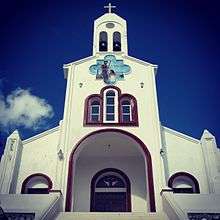La Vallée-de-Jacmel
| La Vallée-de-Jacmel Lavale de Jakmèl | |
|---|---|
| Commune | |
 La Vallée-de-Jacmel Location in Haiti | |
| Coordinates: 18°16′0″N 72°40′0″W / 18.26667°N 72.66667°WCoordinates: 18°16′0″N 72°40′0″W / 18.26667°N 72.66667°W | |
| Country |
|
| Department | Sud-Est |
| Arrondissement | Jacmel |
| Elevation | 800 m (2,600 ft) |
| Population (7 August 2003)[1] | |
| • Total | 36,188 |
La Vallée (Haitian Creole: Lavale) is a commune in the Jacmel Arrondissement, in the Sud-Est Department of Haiti. It has 36,188 inhabitants.
Geography
Situated between the communes of Jacmel et Bainet. The name La Vallée de Jacmel could translate as "The Valley of Jacmel" but it is actually located 800 meters above sea level.
Demography
As of March 2009 Lavallée had 36,188 inhabitants. The small urbanized area of Ridoré had 1039 people with 239 households, roughly about 3.13% of the total population. The area's population has a slightly above the average in Haiti, mixed raced heritage due mostly to French ancestry. Lavallée has an extensive diaspora in the United States and Canada due to a substantial emigration beginning in the 1950s.
Administration
Ridoré is Lavallée's administrative district. The other sublocalities are
- Morne-à-Bruler
- Muzac
- Ternier.
History
Lavallée really started to gain importance by 1910 when it was raised as a parish. The first resident priest was Léon Bonnaud, from Brittany France. Father Bonnaud played a major part in the development of the area setting forth the construction of its first masonry accommodations. The Presbytery in 1912, the St John the Baptist parish church completed in 1922, the boys' school, école Léonce Mégie in 1926, and the girls' school, école St Paul inaugurated in 1931, shortly after his departure. He also built the first dispensary, structured and enlarged the local open air market, one of the most important in the area. Lavallée was a pioneer in the Haitian "cooperative movement" with the founding of the historic "Caisse Populaire" in 1946. An association of locals, created CODEVA in 1975, an organization who initiated many development projects such as building the St Joseph hospital or the Lycée Philippe Jules.
Places of interest

St John the Baptist church, completed In 1922. Bust of Fr. Bonnaud, founder of the parish. Panoramic view of the bay of Bainet, the Caribbean Sea and its surrounding mountains. The open air market fair, every Friday. The L'Etang river and waterfalls. The Séjourné pit, one of the deepest in the Caribbean, 167 meters.
Notable residents
- Mgr. Pétion Laroche, former Roman Catholic bishop of Hinche.
- Marie Carmelle Jean-Marie, Haitian minister of Economy and Finances
- Marc L. Laroche author, Anacaona.
- Cardinal Chibly Langlois bishop of Les Cayes was born in La Vallée
Facilities
The commune is home to the Saint Joseph hospital.[2] A police station, Tribunal. A public high school, the Lycée Philippe Jules. The historic "Caisse Populaire". One hotel, the Auberge du Mont Saint Jean. An inn, the Prag Hotel. A modern bakery at Ternier. A morgue.
Sister cities
-
 Covina, California announced plans to sister up with La Vallee.[3]
Covina, California announced plans to sister up with La Vallee.[3] - Léon Bonnaud, L'Apostolat en Haïti :journal d'un missionnaire. Imprimerie des Apprentis-Orphelins de Saint Michel, 1938.
References
- ↑ Institut Haïtien de Statistique et d'Informatique (IHSI)
- ↑ The Times-Picayune, "New Orleanians pitch in to provide medical aid for Haiti", Katy Reckdahl 23 January 2010 (accessed 25 January 2010)
- ↑ Whittier Daily News, "Covina set to partner with Haitian sister city for support", Maritza Velazquez, 1 March 2010 (accessed 6 March 2010)

